Lomé
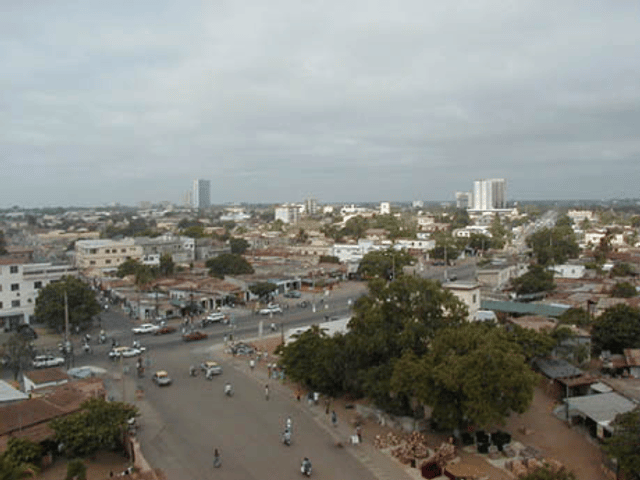
Lomé

Lomé | |
|---|---|
City | |
| Coordinates:6°7′55″N 1°13′22″E [17] | |
| Country | |
| Region | Maritime Region |
| Prefecture | Golfe |
| Government | |
| • Mayor | Aouissi Lodé |
| Area | |
| • City | 99.14 km2(38.28 sq mi) |
| • Metro | 280 km2(110 sq mi) |
| Elevation | 10 m (30 ft) |
| Population (2010 census) | |
| • City | 837,437 |
| • Density | 9,305/km2(24,100/sq mi) |
| • Metro | 1,477,660 |
| • Metro density | 5,608/km2(14,520/sq mi) |
| Time zone | UTC |
| HDI (2017) | 0.593[1] medium· 1st |
Lomé is the capital and largest city of Togo. It has an urban population of 837,437[2] while there were 1,570,283 permanent residents in its metropolitan area as of the 2011 census.[2] Located on the Gulf of Guinea, Lomé is the country's administrative and industrial center, which includes an oil refinery, and its chief port, where it exports coffee, cocoa, copra, and oil palm kernels.
Lomé | |
|---|---|
City | |
| Coordinates:6°7′55″N 1°13′22″E [17] | |
| Country | |
| Region | Maritime Region |
| Prefecture | Golfe |
| Government | |
| • Mayor | Aouissi Lodé |
| Area | |
| • City | 99.14 km2(38.28 sq mi) |
| • Metro | 280 km2(110 sq mi) |
| Elevation | 10 m (30 ft) |
| Population (2010 census) | |
| • City | 837,437 |
| • Density | 9,305/km2(24,100/sq mi) |
| • Metro | 1,477,660 |
| • Metro density | 5,608/km2(14,520/sq mi) |
| Time zone | UTC |
| HDI (2017) | 0.593[1] medium· 1st |
History
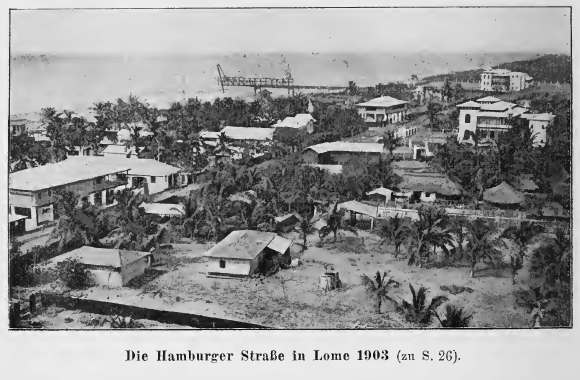
Lomé in 1903.
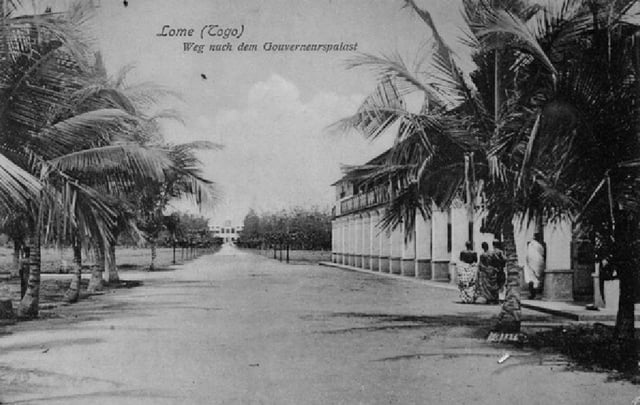
Alley leading to the Governor's Palace (1904).
The city's population grew rapidly in the second half of the 20th century. The city had approximately 30,000 inhabitants in 1950: by 1960 (the year Togo gained its independence from France) the population had reached 80,000, increasing to 200,000 by 1970.
Geography
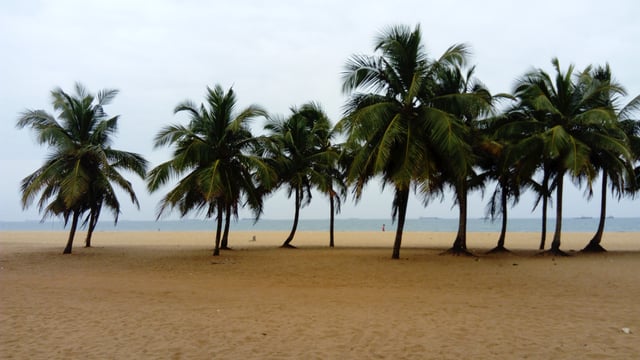
View of the Lomé beach in 2016

Aerial view of Lomé
Lomé is surrounded by a lagoon to the north, the Atlantic Ocean to the south, the village of Bè to the east and the border of Aflao, Ghana to the west.
Neighborhoods in Lomé include Ablogamé, Adawlato, Amoutivé, Bé, Dékon, Forever, Kodjoviakopé, Noukafou, Nyékonakpoé, Tokoin and Xédranawoe.
Cities and towns in the Greater Lomé Metropolitan Area include: Aflao (Ghana), Agbalépédogan, Akodésséwa, Anfamé, Baguida, Kanyikopé, Kélékougan, Lomé II, Totsigan, Adidogome, Kegue and Totsivi.
Climate
Lomé has a tropical savanna climate (Köppen climate classification Aw) despite its latitude close to the equator. The capital of Togo is relatively dry with an annual average rainfall of 800–900 mm and on average 59 rainy days per year. Despite this, the city experiences heavy fog most of the year and receives a total of 2330 bright sunshine hours annually.
The annual mean temperature is above 27.5 °C (81.5 °F) but heat is constant as monthly mean temperatures range from 24.9 °C (76.8 °F) in July, the least warm month of the year to 29.6 °C (85.3 °F) in February and in April, the hottest months of the year.
| Climate data for Lomé (Lomé Airport) 1961–1990, extremes 1892–present | |||||||||||||
|---|---|---|---|---|---|---|---|---|---|---|---|---|---|
| Month | Jan | Feb | Mar | Apr | May | Jun | Jul | Aug | Sep | Oct | Nov | Dec | Year |
| Record high °C (°F) | 35.7 (96.3) | 36.4 (97.5) | 36.3 (97.3) | 35.0 (95.0) | 34.8 (94.6) | 36.4 (97.5) | 32.8 (91.0) | 36.5 (97.7) | 35.5 (95.9) | 33.8 (92.8) | 38.1 (100.6) | 34.5 (94.1) | 38.1 (100.6) |
| Average high °C (°F) | 31.7 (89.1) | 32.3 (90.1) | 32.5 (90.5) | 32.1 (89.8) | 31.3 (88.3) | 29.6 (85.3) | 28.2 (82.8) | 28.0 (82.4) | 29.1 (84.4) | 30.4 (86.7) | 31.6 (88.9) | 31.6 (88.9) | 30.7 (87.3) |
| Daily mean °C (°F) | 27.1 (80.8) | 28.2 (82.8) | 28.5 (83.3) | 28.2 (82.8) | 27.4 (81.3) | 26.2 (79.2) | 25.3 (77.5) | 25.2 (77.4) | 25.8 (78.4) | 26.6 (79.9) | 27.3 (81.1) | 27.1 (80.8) | 26.9 (80.4) |
| Average low °C (°F) | 22.5 (72.5) | 24.0 (75.2) | 24.5 (76.1) | 24.4 (75.9) | 23.5 (74.3) | 22.8 (73.0) | 22.5 (72.5) | 22.3 (72.1) | 22.5 (72.5) | 22.8 (73.0) | 22.9 (73.2) | 22.5 (72.5) | 23.1 (73.6) |
| Record low °C (°F) | 15.2 (59.4) | 16.7 (62.1) | 19.9 (67.8) | 20.0 (68.0) | 19.2 (66.6) | 18.0 (64.4) | 16.7 (62.1) | 17.1 (62.8) | 18.0 (64.4) | 16.4 (61.5) | 18.6 (65.5) | 15.6 (60.1) | 15.2 (59.4) |
| Average precipitation mm (inches) | 8.9 (0.35) | 23.1 (0.91) | 53.4 (2.10) | 96.1 (3.78) | 152.7 (6.01) | 251.8 (9.91) | 91.0 (3.58) | 32.7 (1.29) | 64.7 (2.55) | 74.6 (2.94) | 20.4 (0.80) | 7.8 (0.31) | 877.2 (34.54) |
| Average precipitation days(≥ 1.0 mm) | 0 | 2 | 3 | 5 | 9 | 11 | 6 | 4 | 6 | 6 | 2 | 1 | 57 |
| Average relative humidity (%) | 79 | 81 | 82 | 82 | 84 | 86 | 87 | 86 | 86 | 85 | 84 | 82 | 84 |
| Mean monthly sunshine hours | 222.4 | 214.8 | 228.0 | 218.0 | 217.8 | 141.3 | 135.4 | 147.5 | 168.4 | 218.0 | 240.6 | 227.2 | 2,379.4 |
| Source #1: Deutscher Wetterdienst[5] | |||||||||||||
| Source #2: NOAA (sun 1961–1990),[6] Meteo Climat (record highs and lows)[7] | |||||||||||||
| Jan | Feb | Mar | Apr | May | Jun | Jul | Aug | Sep | Oct | Nov | Dec |
|---|---|---|---|---|---|---|---|---|---|---|---|
| 28 °C (82 °F) | 28 °C (82 °F) | 29 °C (84 °F) | 29 °C (84 °F) | 29 °C (84 °F) | 28 °C (82 °F) | 26 °C (79 °F) | 25 °C (77 °F) | 25 °C (77 °F) | 27 °C (81 °F) | 28 °C (82 °F) | 28 °C (82 °F) |
International agreements
Lomé Convention
The Lomé Convention is a trade and aid agreement between the European Union (EU) and 71 African, Caribbean, and Pacific (ACP) countries. It was first signed on 28 February 1975, in Lomé.[8]The first Lomé Convention (Lomé I), which came into force in April 1976, was designed to provide a new framework of cooperation between the then European Community (EC) and developing ACP countries, in particular former British, Dutch, Belgian and French colonies. It had two main aspects. It provided for most ACP agricultural and mineral exports to enter the EC free of duty. Preferential access based on a quota system was agreed for products, such as sugar and beef, in competition with EC agriculture. Secondly, the EC committed to the ECU for 3 billion in aid and investment in the ACP countries.
The convention was renegotiated and renewed three times. Lomé II (January 1981 to February 1985) increased the aid and investment expenditure for the ECU to 5.5 billion. Lomé III came into force in March 1985 (trade provisions) and May 1986 (aid), and expired in 1990; it increased commitments to ECU by 8.5 billion. Lomé IV was signed in December 1989. Its trade provisions cover ten years, 1990 to 1999. Aid and investment commitments for the first five years amounted to 12 billion. In all, some 70 ACP states are party to Lomé IV, compared with the 46 signatories of Lomé I.
Lomé Peace Accord
The Lomé Peace Accord between the warring parties in the civil war in Sierra Leone was signed in Lomé. With the assistance of the international community, Sierra Leone President Ahmad Tejan Kabbah and Revolutionary United Front leader Foday Sankoh signed the Peace Accord on 7 July 1999. However, the agreement did not last and the Sierra Leone Civil War continued for two more years.
Demographics
| Historical population | |||||||||||||||||||||||||||||||||||||||||||||||||||||||
|---|---|---|---|---|---|---|---|---|---|---|---|---|---|---|---|---|---|---|---|---|---|---|---|---|---|---|---|---|---|---|---|---|---|---|---|---|---|---|---|---|---|---|---|---|---|---|---|---|---|---|---|---|---|---|---|
|
| ||||||||||||||||||||||||||||||||||||||||||||||||||||||
Economy
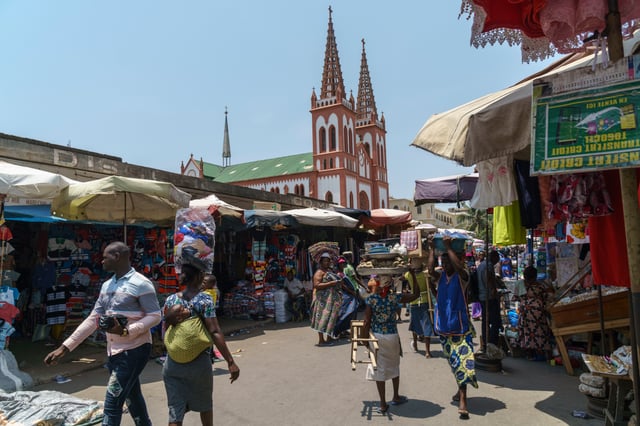
Lomé Grand Market
Located 200 kilometres (124 miles) from Accra, Ghana and 150 kilometres (93 miles) from Cotonou, Benin, Lomé is an important port, including a free trade zone opened in 1968. It exports phosphates, coffee, cocoa, cotton and palm oil, much of the transit going to the neighbouring countries of Ghana, Mali, Niger and Burkina Faso. The port also holds an oil refinery.
The city in general has great potential, because tourism is growing in the country. However, political instability that began to surface in the passing years and continues today has seriously affected the country's tourism sector. In 2003, the country received 57,539 visitors, an increase of 1% compared to 2002. 22% of tourists came from France, 10% from Burkina Faso and 9% were from Benin.
Architecture
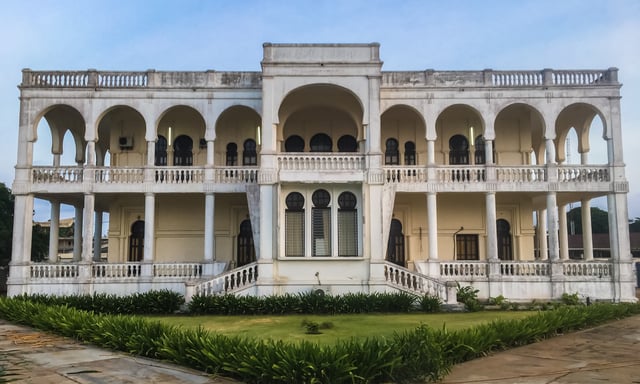
Former building of the Ministry of Justice
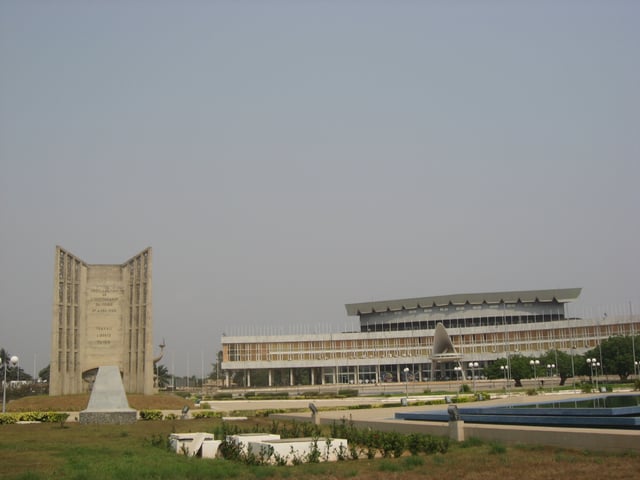
Congress Palace

Headquarters of ECOWAS in Lomé
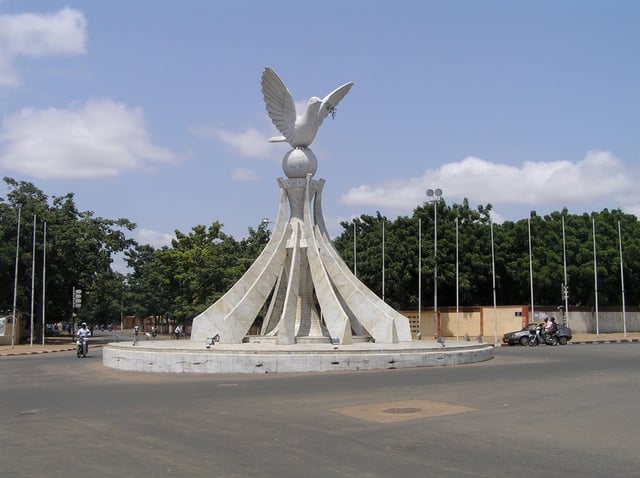
Place of the Dove of Peace
The city of Lomé is a typical African city in the sense that many styles, influences, and traditions are mixed. The landscape combines red earth, with grand boulevards and large squares, green gardens and colourful houses.
There are some remnants of colonial architecture from the turn of the century, such as arcades and galleries and the Cathedral of the Sacred Heart designed in the German Gothic style. There are also many modern buildings, like the headquarters of the BCEAO, the BTCI, the magnificent edifice of ECOWAS, Hotel de la Paix, the Hotel Mercure Sarakawa, Palm Beach Hotel and the famous Hotel du 2 Fevrier, rising to 102 metres.
Not far away is the Lomé Grand Market, with a large 3-storey hall. It sells everything from red peppers, green lemons, and dried fish, to combs, travel bags, and traditional medicinal remedies. There are spices like cinnamon sticks, star anise, clove and nutmeg.[9] On the first floor is the Nana Benz, which is noted for its clothing. Nearer the centre of the city, there is the Akodessewa market, which is much more specialized than the general market. There are fetishes, gongons, and gris-gris.
The coast is considerably less frantic than the market, with local fishermen quietly pushing their large boats out to sea. To the west of the city is a residential area that faces the sea. The area has long streets, dotted by official government buildings excluding the Palace of Justice and the various embassies and consulates. East to the port there is fishermen's market (Marché du port de pêche). The market is being used by local fishermen to sell their fish directly to the vendors. The market is the entry point for the canoes used by the fishermen.
Farther north, near the Monument of Independence, is the house of the Rally of the Togolese People (RPT), a major convention center.
Culture
The Togo National Museum is in the Palais de Congrès. The museum contains collections, jewelry, musical instruments, dolls, pottery, weapons and many other objects showing the arts and traditions.
Places of worship
Among the places of worship, they are predominantly Christian churches and temples : Roman Catholic Archdiocese of Lomé (Catholic Church), Evangelical Presbyterian Church of Togo (World Communion of Reformed Churches), Togo Baptist Convention (Baptist World Alliance), Living Faith Church Worldwide, Redeemed Christian Church of God, Assemblies of God.[10] There are also Muslim mosques.
Education
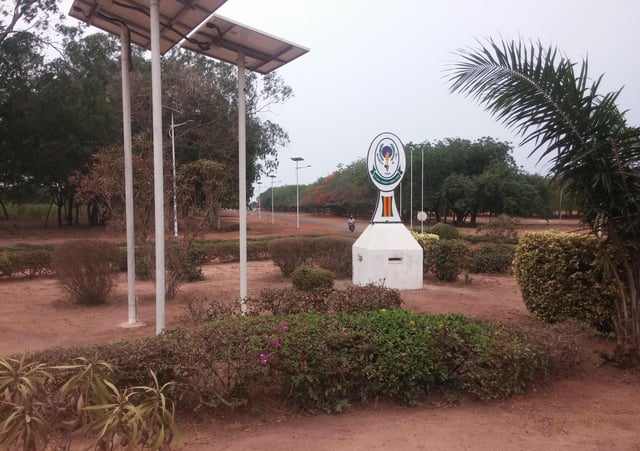
Entrance of University of Lomé
The University of Lomé (previously called University of Benin), located in Lomé Tokoin, was founded in 1970.
Schools located in the city include American International School of Lomé, British School of Lomé, Ecole Internationale Arc-en-Ciel and Lycée Français de Lomé.
Transportation
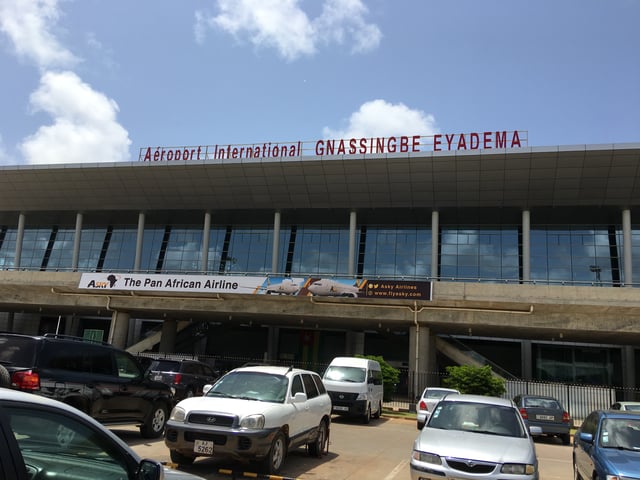
Lomé–Tokoin International Airport
The city is served by the Lomé–Tokoin International Airport which is the hub for ASKY Airlines and has intercontinental connections to Paris, Brussels, Lisbon and Newark-New York. The former railway line to Blitta runs from the airport to the city. In Lomé, and in many other places in Togo, moto-taxis are a common form of transportation. Motorcycle drivers fill the streets and passengers flag them down for a ride on the back for a small charge.
International relations
Twin towns — sister cities
Lomé is twinned with:
[[INLINE_IMAGE|//upload.wikimedia.org/wikipedia/commons/thumb/f/fa/Flag_of_the_People%27s_Republic_of_China.svg/23px-Flag_of_the_People%27s_Republic_of_China.svg.png|//upload.wikimedia.org/wikipedia/commons/thumb/f/fa/Flag_of_the_People%27s_Republic_of_China.svg/35px-Flag_of_the_People%27s_Republic_of_China.svg.png 1.5x, //upload.wikimedia.org/wikipedia/commons/thumb/f/fa/Flag_of_the_People%27s_Republic_of_China.svg/45px-Flag_of_the_People%27s_Republic_of_China.svg.png 2x|China|h15|w23|thumbborder flagicon-img flagicon-img]] Shenzhen, China, since 1993[11][12][13]
Notable people
Emmanuel Adebayor, footballer for Togo and İstanbul Başakşehir
Kangni Alem, writer
Gnimdéwa Atakpama, journalist and writer
Nicole Coste, Air France flight attendant, mother of Alexandre Coste (the son of Albert II, Prince of Monaco)
Christiane Akoua Ekué, writer
Emmanuel Kavi, artist
King Mensah, popular Afropop musician
References
- Philippe Gervais-Lambony (2011), Simon Bekker and Goran Therborn (ed.), "Lomé", Capital Cities in Africa: Power and Powerlessness, Dakar: Council for the Development of Social Science Research in Africa, ISBN 978-2- 8697-8495-6

